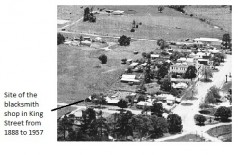BLACKSMITHS
The earliest European settlers in the Yarra Glen district such as Ryrie, Dixon, and Stevenson would have employed a blacksmith, or at least a farrier, on their stations. Twenty years later, in 1862, the Yarra Track was established to provide a route from Eltham to new goldfields at Woods Point. Thomas Muncaster Bell saw an opportunity and by 1864 had built the Yarra Flats Hotel and a store (now Apple Porch Cottage). On the southern side of the store he set up a blacksmith shop to serve the passing traffic. This smithy was operated by a number of different proprietors until the late 1930s.
For many years there was a smithy at both ends of the town. When the railway was built in 1887-1888 John Francis Smedley (1853-1941) and John William Shaw (1860-1933) established a blacksmith shop in King Street and called it the Railway Forge Blacksmith. John Shaw was a wheelwright and coach builder. They sold the business to Charles and Thomas Bath in March 1888 who operated the business in partnership as Bath Brothers. The partnership dissolved in 1899 and was continued by Thomas Bath until 1902. Walter Francis Bell (1877-1934) was working as a blacksmith during this period. Although the exact date is not known Wattie took over the blacksmith and wheelwright business that had belonged to the Baths. Wattie Bell died in July 1934 and the business was then run by his son William (Bill) Bell (1904-1965).
Other blacksmiths at Yarra Flats and Yarra Glen include William Hannah (d.1866), George Boswell, 1868, Francois the Frenchman, 1875, Albert Henry Woodhead 1888-1896, James Masters 1890-1895, George Provis Bull 1903-1910, Lorenz MacKenzie c.1922-1924, James Walter Coburn, 1924-1925, and Rowland Mills 1925-1926. Some of these operated the smithy near the Yarra Flats Hotel. In the late 1930s this smithy closed and from the Second World War until the late 1950s there was only the one blacksmith shop, in King Street.
After the second World War demand for the services of a blacksmith decreased. Bill Bell spent more of his time dairy farming, only attending the blacksmith shop when a job presented. The last entries in the ledger were in February 1957. Several farriers now operate in the district, usually with a mobile service

